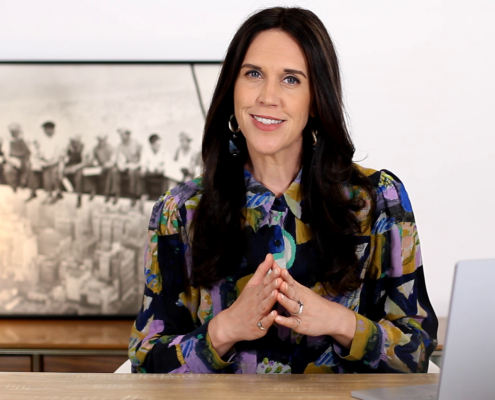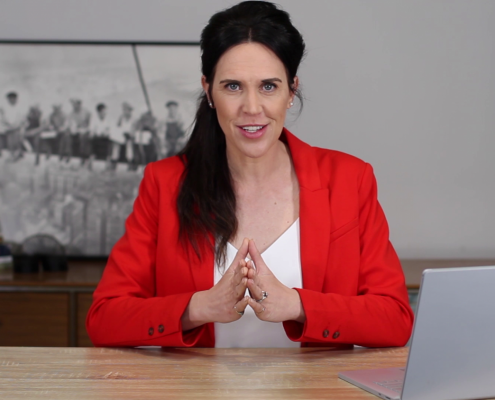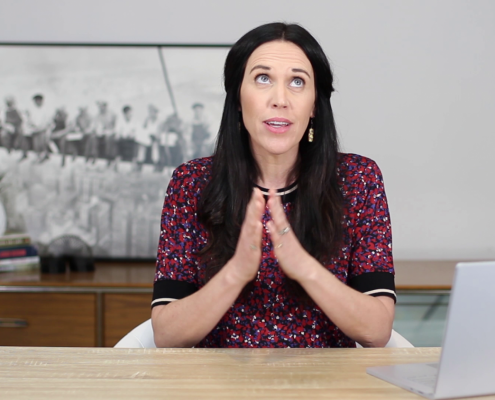THE FUTURE IS BRIGHT – HEALTH & SAFETY STRATEGIC FORESIGHT BY CSIRO’s DATA61
Last month, Safe Work Australia, in collaboration with CSIRO’s Data61, Australia’s leading data innovation group, commissioned a strategic foresight report that considers six megatrends that will re-shape workplace health & safety (WHS) and workers compensation over the next 20 years:
- The extending reach of automated systems and robotics
- Rising issue of workplace stress and mental health issues
- Rising screen time, sedentary behaviour and chronic illness
- Blurring the boundaries between work and home
- The gig and entrepreneurial economy
- An aging workforce
In this post, I pull out the highlights from the report because looking externally is an essential activity to crafting your WHS strategy.
It will be imperative for businesses to understand how automation and robots can affect the safety of business tasks and processes. @Data61newsClick To TweetFor clarity, a megatrend is a deep-set trajectory of change that occurs at the intersection of numerous trends with tighter and more specific temporal, spatial and typological definitions. They develop gradually but eventually reshape the environment.
With the coming 20 years bringing significant changes that are likely to have disruptive impacts on the Australian working environment, anticipating these impacts and preparing for a range of plausible futures is an important step in ensuring the long-term effectiveness of Australian WHS.
The CSIRO Data61 report is intended to provide advance notice of the potential challenges, risks and opportunities expected to change workplaces over the next 20 years, with a particular focus on advances in Information Communication Technology (ICT) and enabled platforms (EPs), and the associated rise of new economic structures and business models which utilise those advances.
ICT-EPs relate to the digitisation, AI, and robotics. They include technologies that generate and transmit information as well as technologies dependent on ICT, such as wearables and autonomous vehicles.
WHY BUSINESS LEADERS SHOULD READ THIS
New employment models, job designs, labour markets and social expectations will reshape the requirements and expectations of effective WHS and workers’ compensation and will impact on every business in some way or another.
Physical and psychological workplace injury is predicted to fall by 11% by 2030 as a result of more pervasive automation in the workplace – so, are you using automation in your business to prevent WHS risk?
Just as importantly, are you aware of the risks that automation will bring? If not, take the time to read through this post so that you’re better informed to know what to ask and when to act #KnowWTA.
Today’s post will help you identify where the Australian WHS climate is heading and whether you and/or your health & safety team have identified these themes in order to monitor the impact on your business.
SIX MEGATRENDS TO RE-SHAPE WHS OVER THE NEXT 20 YEARS
1. The extending reach of automated systems and robotics
The costs of advanced automated technologies are likely to continue falling and the capabilities and widespread deployment are likely to continue rising.
This will see a push to automate systems currently operated by humans, presenting both challenges and opportunities from a WHS and workers’ compensation perspective.
For example, as autonomous systems enter more ‘human’ professions involving advanced cognitive function, they could also start to replace work in white-collar professions – such as jobs that are highly routinised and skilled in ways that can be programmed.
Recent strides made in the effort to build ‘artificial brains’ (machines with creativity and intelligence equal to humans) suggest that this development is not far off.
Estimates of the numbers of jobs that may be replaced by robotics and AI over the next decade range from 9 to 43% and industries such as road transport, agriculture and construction are seeing the introduction of commercial unmanned vehicles. Most examples of unmanned vehicles include drones, or remotely piloted aircraft. However, large-scale investment and trials are occurring with regards to automation in vehicles, farm machinery and construction equipment
Automation can make the workplace safer
Physical and psychological workplace injury is predicted to fall by 11% by 2030 as a result of more pervasive automation in the workplace.
However, as the use of robots grows, workers at all levels will be more likely to be working in physical proximity to automation.
It will be imperative for businesses to understand how automation and robots can affect the safety of business tasks and processes.
Current risk assessment processes in Australia may need to be reviewed to ensure that these adequately identify the relevant risks.
The impact of automation on mental health is largely unknown
As robotics, AI and machine learning replace the least interactive, least stimulating and least satisfying jobs in the workplace, the positions of value will increasingly be the ones involving more human-orientated traits – interpersonal skills, creative reasoning and entrepreneurialism.
This may introduce greater workplace stress as a result of spending a greater proportion of time on higher functioning tasks and increased worker surveillance and time management by automated systems.
Robotics and autonomous systems are blurring the lines of responsibility for error and injury
The safety of autonomous systems, in particular autonomous vehicles and AI medical diagnostics is the subject of considerable and ongoing legal debate. Case law interpreting WHS and workers’ compensation laws is still developing along with the technology.
Unlike human judgement, autonomous systems are often interdependent on other systems – the internet, GPS technology, IoT systems, wireless networks and central databases – and are open to hacking or remote interference.
This was recently highlighted when a U.S.A. pacemaker manufacturer recalled pacemakers surgically inserted in thousands of people worldwide, due to the risk of them being hacked.
Upstream duties for automated systems
As plant becomes more automated and connected, ambiguities may arise around these duties. The possibility of automated systems being connected to the internet means that their safety could be compromised by hackers; therefore,
Should those responsible for an organisation’s cybersecurity also have WHS duties for WHS in automated systems?
Furthermore, if a programmer provides regular software updates to plant, they may also retain some control over the system – simultaneously occupying the position of ‘designer’ and ‘person with management or control of fixtures, fittings or plant at a workplace’, which makes them a duty holder.
AI and workers’ compensation insurance
The rise of AI and the IoT may see insurance companies better able to collect and analyse more data about their customers and better predict risk.
Some companies already offer discounted insurance to customers who allow their insurer access to data about their behaviour. This is known as behavioural policy pricing.
2. Rising issue of workplace stress and mental health issues
Australia’s workforce is registering increasing levels of stress and mental health issues. New and intensifying uses of digital technologies in the workplace may exacerbate problems with mental health and stress, but technology also presents opportunities to manage these issues.
Digital technologies can assist in mental health treatments and monitoring
Australia has been a world leader in developing approaches to online and telephone based mental health services.
Advances in medical technologies – such as wearable sensors, brain stimulation and imaging, and exome and whole-genome sequencing – are providing ground-breaking opportunities to study the biological factors associated with mental health at a microscopic level.
AI can be used as a tool to help fight anxiety and depression. Developments in psychological AI technology are allowing people access to affordable, on-demand mental healthcare.
For example, X2AI’s ‘Tess’ holds conversations with people to help with their emotional problems by educating them on coping mechanisms and encouraging emotional wellbeing. Using existing technology-based communications such as SMS and instant messaging applications, Tess monitors the user by analysing their emotional state and returns appropriate comments, questions and recommendations. It is likely technological developments such as Tess and other similar psychological AI will contribute to ongoing improvement in understanding, support and awareness of mental health issues, thus presenting an opportunity to reduce psychological injuries.
These advances may lead to better treatment options and outcomes for rehabilitating workers with psychological injuries and returning them to work.
The downside of technology on mental health
However, workplace stress associated with technology can be caused by a number of factors, including:
- increased employee monitoring
- rising performance and productivity expectations
- increased work out of normal business hours
- the frequent need to learn how to use new systems
- lack of human interaction enabled by technology
- lack of workforce consultation and involvement around the implementation of new technologies.
Therefore, as ICT-EPs become more widespread in workplace settings, there may be an increase in mental-health related WHS issues and workers’ compensation claims.
3. Rising screen time, sedentary behaviour and chronic illness
The amount of daily screen time has grown for both adults and children and there is a continued drift away from manual jobs towards sedentary jobs (generally defined as sitting or lying down).
As such, rates of obesity, cardiovascular disease, type 2 diabetes, and other chronic illnesses continue to rise.
Causality of lifestyle-related risk factors is difficult to establish
This raises questions around the delineation of responsibility. For instance, if a job requires largely sedentary work,
Can the person conducting the business or undertaking (PCBU) be held accountable for employees being overweight and developing associated conditions or injuries?
Can an employee in a high-stress job who develops hypertension and/or cardiovascular disease attribute causality to their work?
The current approach to claims assessment generally errs on the side of not attributing lifestyle diseases to work conditions. Lifestyle illnesses are currently unlikely to be the basis of workers’ compensation claims, but they may make workers more susceptible to other illnesses or injuries which are eligible for workers’ compensation.
Obesity is an important factor in the total chronic disease burden
Australia was the fifth most obese country out of 35 OECD countries in 2017. Obesity accounts for 7% of Australia’s disease burden.
Obesity caused 10% of chronic musculoskeletal conditions in 2011, of which it caused 44.6% of osteoarthritis cases – an issue highly relevant to increased WHS risk.
There is also significant evidence that workers who are overweight are at higher risk of sustaining workplace injuries, particularly musculoskeletal disorders.
Digital technology can help reduce the risks of screen time and sedentary behaviour
There is the potential for digital technology to influence human decision making in order to invoke behaviour-based safety. This could be achievable through the use of wearables, such as smart watches and smart glasses, or even the design of various user interfaces.
Successful digital innovation has produced digital platforms that can aid in diabetic management, or smoking cessation, or to digitally deliver services in cognitive behavioural therapy (CBT).
4. Blurring the boundaries between work and home
An increasingly large share of Australian workers are entering into work arrangements that enable them to work from home or other locations, blurring the boundaries between work and home life.
Teleworking and WHS
Under the model WHS Act, a PCBU is required to ensure, so far as is reasonably practicable, the health and safety of workers while at work. This duty applies regardless of where a worker is performing their work.
As such,
employers are generally found to have liability for work-related incidents that occur in the home – as demonstrated in several high-profile successful workers’ compensation claims from employees who were injured while trying to complete work-related tasks at home.
Teleworking and mental health
Research has found telework can be associated with increased role ambiguity and reductions in support and feedback, leading to negative job engagement.
If not managed well it can also isolate workers.
Blurred boundaries between work and home could negatively impact an employee’s work–life balance, if work hours and patterns are undefined.
Digital technologies are establishing trust in teleworking
The OECD has suggested that the IoT could make use of sensors to establish an ‘Internet of Trust’, with greater visibility of remote workplaces and supply chains.
The IoT could provide faster and more detailed information, conducive to better decision making in terms of productivity and health and safety.
Teleworking may facilitate labour force participation and improve job satisfaction
For example, research has found:
- 60% of mature workers would take NBN-enabled telework if it were available to them, effectively allowing them to delay retirement by an average of 6.6 years
- 73% of those not in the labour force with family or carer duties would take NBN-enabled teleworking opportunities if they could, allowing them to return to the workforce
- 70% of those not in the labour force in regional and remote Australia would take telework employment if given the opportunity, allowing them to enter the workforce.
Teleworking can improve job satisfaction
A recent McCrindle Research study found 80% of people surveyed stated that they would be more likely to remain with an employer if their jobs provided flexibility or remote working. Research has also found that home-based workers reported higher job satisfaction than main-office workers, valuing the flexibility and autonomy of telework.
However, the relationship between teleworking and worker mental health is complex.
While teleworking increases job satisfaction, it can also cause workers to become isolated, increase mental stress and lead to a breakdown of the delineation between work and home life.
5. The gig and entrepreneurial economy
The gig economy refers to freelance task-based work (aka a ‘gig’) organised through online platforms or ‘apps’. It changes the way we work away from traditional employment models.
Although the Australian gig economy is still relatively small, there has been rapid growth in the worldwide gig economy, but its impact on the Australian labour market is unclear.
Gig economy platforms often argue their workers are ‘independent contractors’ rather than employees and that the primary relationship is between the consumer and the worker not the platform and the worker. As independent contractors, they may be treated the same as employees under WHS laws, but may be prevented from accessing workers’ compensation.
The classification of gig economy workers in Australia is widely anticipated to be disputed in the Courts in Australia in the coming years as interested parties search for clarity on the application of the law to gig economy workers. Until there is clarification in Courts or through regulatory reform the classification of gig economy workers will remain uncertain.
Platforms have different levels of control and ability to anticipate and manage WHS risks. Policymakers will need to consider these new and emerging business structures to ensure that the WHS and workers’ compensation frameworks are ft for purpose.
Who manages safety?
A challenge in regulating WHS in the gig economy is the different business models and the levels of control platform companies have over the work being undertaken.
In most cases platforms will be PCBUs and have associated WHS duties, as may gig workers. However, these duties will be qualified by what is ‘reasonably practicable’, which will take into account ‘what the person concerned knows, or ought reasonably to know, about the hazard or the risk.’ These parameters are likely to be tested through case law.
Gig economy workers performing a specific task (e.g. Uber drivers) are likely to encounter a fairly uniform set of WHS risks, which Uber could reasonably be expected to manage.
However, gig economy workers on ‘miscellaneous task’ platforms (e.g. Airtasker, Gobi, Freelancer, etc.) are likely to encounter a far broader range of risks within a variety of environments. The platform may find it difficult to manage these risks and may have little to no influence over how or where work is performed.
In some circumstances it may be the consumer who has duties to manage WHS and their knowledge of this and ability to do so may be limited.
Finding effective methods to articulate, manage, and minimise these risks
These may not come in the form of traditional WHS management systems but could include platforms providing general information and education around risks and safety management.
6. An ageing workforce
The average age of Australia’s workforce is increasing along with the ageing of the population as a whole, and older Australians are having to stay in the workforce longer.
Changing patterns of employment present opportunities for an older workforce
In Australia, employment is trending downwards in manual-labour industries such as manufacturing, agriculture and mining and upwards in white collar industries like education and training; professional, scientific and technical services; and public administration and safety are gaining in employment share.
This shift is likely to enable older Australians to stay in the workforce for longer and with lower WHS risks, as these occupations involve fewer physical demands.
An older workforce is more susceptible to being overweight or obese
Most recent Australian Bureau of Statistics (ABS) data show that around 70% of people aged 55–64 are classified as overweight or obese, compared with 37% of people aged 18–24.
Age-based discrimination
Research shows that older workers are, on the whole, more likely to become victims of workplace bullying.
The Australian Human Rights Commission cites numerous cases of older workers who have been targeted by jokes and comments about retirement, ignored and isolated by colleagues, and not given enough time by managers to learn new skills.
This may be exacerbated by the increasing use of technology in the workplace, which may prove difficult for older employees.
The Australian Digital Inclusion Index (ADII) – measuring digital inclusion through the indicators of access, ability and affordability – finds that Australians aged 50–64 have an average ADII score of 52.6 (compared to a national average of 54.5), scoring lowest within the ‘Ability’ category.
Technology presents new opportunities
Although older workers have different and often additional needs from a WHS perspective, these can also be opportunities for new technologies and innovations.
For instance, Japan’s ageing population is driving demand for machine-assistive technologies so that older workers can stay employed and injury-free.
For example, Japanese hauling company Tatsumi Shokai Logistics has recently invested in a robot exoskeleton to take the physical strain off its workers.
As technological capabilities advance, these innovations are likely to become more widespread and will need to be recognised and incorporated into WHS models and practices.
That’s a wrap!
I hope this summary of the Data61 report will help inform your strategic decision-making and give you insight into the future of Australia’s WHS climate. Use this information to have more informed discussions with your health & safety team, or advisor on whether your WHS strategy is on the right track, particularly in how you are using or thinking of using automation and ICT-EPs. The future is bright!
Now I’d like to hear from you:
Have you captured any of these trends in your WHS strategy? If so, which ones concern you most? And why?
Leave a comment below and let me know.
Remember, share as much detail as possible in your reply. Your story and/or thoughts may lead to someone’s meaningful breakthrough and it all contributes to this audience knowing What to Ask, and When to Act #knowWTA
Important: share your thoughts and ideas directly in the comments. Links to other posts, videos, etc. will be removed.
Thank you so much for adding your perspective to the conversation!
Thanks for reading!
Welcome!
I’m Samantha
I teach board members and executives how to lead with heart and put people first, by leading safe & healthy work. Stick around and I’ll share with you the skills, knowledge and mindset you need to know what to ask, and when to act and lead with confidence.
RESOURCES
YOU MAY ALSO LIKE…
FEATURED CONTENT
[text-blocks id=”4249″ plain=”1″]








Let us know what you have to say:
Want to join the discussion?Your email address will not be published.